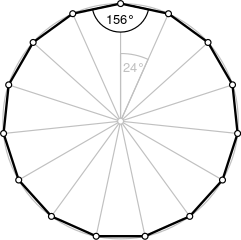Product and cos
 k
=
1
∏
1
4
cos
(
1
5
k
π
)
=
?
k
=
1
∏
1
4
cos
(
1
5
k
π
)
=
?
Image Credit: Wikimedia László Németh .
This section requires Javascript.
You are seeing this because something didn't load right. We suggest you, (a) try
refreshing the page, (b) enabling javascript if it is disabled on your browser and,
finally, (c)
loading the
non-javascript version of this page
. We're sorry about the hassle.
1 solution
Moderator note:
There's a much simpler approach. Are you familiar with Chebyshev Polynomials?
Another simple and direct solution by by using this identity k = 1 ∏ n − 1 cos ( n k π ) = 2 n − 1 sin ( π n / 2 )
Log in to reply
Wow. Nice identity. How to prove this?
Log in to reply
Enjoy Mr. Pi Han Goh....... If n is even, then cos ( 2 π ) = 0 appears in the product w h e n k = n / 2 and sin ( 2 n π ) = 0
If n is odd, then combining z = 1 lim z + 1 z n + 1 = 1 ( 2 a ) z + 1 z n + 1 = k = 1 ∏ n − 1 ( z + e 2 π i k / n ) ( 2 b ) 1 + e i 2 k π / n = 2 cos ( k π / n ) e i k π / n ( 2 c ) and noting that k = 1 ∑ n − 1 k = 2 n ( n − 1 ) so that k = 1 ∏ n − 1 e i k π / n = ( − 1 ) ( n − 1 ) / 2 which matches the sign of sin ( π n / 2 ) , yields 2 n − 1 k = 1 ∏ n − 1 cos ( k π / n ) = ( − 1 ) ( n − 1 ) / 2 = sin ( π n / 2 )
Log in to reply
@Refaat M. Sayed – OH MY GOD YOU ROCK!!
You should post this here !
Log in to reply
@Pi Han Goh – I will do... by the way are you challenge Master???
Log in to reply
@Refaat M. Sayed – ahah no. But @Calvin Lin is.
Log in to reply
@Pi Han Goh – OH.... Calvin Lin that is great
Assume that x = k = 1 ∏ 1 4 cos ( 1 5 k π ) y = k = 1 ∏ 1 4 sin ( 1 5 k π ) x . y = k = 1 ∏ 1 4 sin ( 1 5 k π ) cos ( 1 5 k π ) x . y = k = 1 ∏ 1 4 2 1 sin ( 1 5 2 k π ) = ( 2 1 ) 1 4 sin ( 1 5 2 π ) sin ( 1 5 4 π ) ⋯ sin ( 1 5 1 4 π ) sin ( 1 5 1 6 π ) sin ( 1 5 1 8 π ) ⋯ sin ( 1 5 2 8 π ) Now : sin ( 1 5 1 6 π ) = ( − 1 ) sin ( 1 5 π ) & sin ( 1 5 1 8 π ) = ( − 1 ) sin ( 1 5 3 π ) & ⋯ & sin ( 1 5 2 8 π ) = ( − 1 ) sin ( 1 5 1 3 π ) x . y = ( 2 1 ) 1 4 ( − 1 ) 7 [ sin ( 1 5 2 π ) sin ( 1 5 4 π ) ⋯ sin ( 1 5 1 4 π ) sin ( 1 5 π ) sin ( 1 5 3 π ) ⋯ sin ( 1 5 1 3 π ) ] x . y = ( 2 1 ) 1 4 ( − 1 ) 7 . y so : x = − ( 2 1 ) 1 4